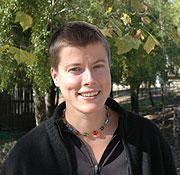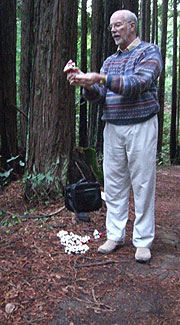November 27, 2006
Science and Justice Working Group promotes interdisciplinary discussion
By
Jennifer McNulty
Capitalizing on UCSC's strengths in scientific and social justice research, Assistant Professor Jenny Reardon of sociology has created a new Science and Justice Working Group on campus.

The Working Group formed by Jenny Reardon, above, went on a short "walk in the woods" led by David Deamer, below, professor of chemistry and biochemistry, to explore the ways in which people from different academic disciplines see and interpret the natural environment.
Photo above: Jennifer McNulty
Photo below: Shannon Williams |
 |
Established this fall, the new group brings together faculty and graduate students from all five academic divisions on campus--arts, humanities, social sciences, engineering, and physical and biological sciences--to promote interdisciplinary discussion.
Reardon, whose own research focuses on science and society, said UCSC seemed like the perfect place for an interdisciplinary initiative to bridge the historical divide between engineering and the sciences and other disciplines.
"There's a growing desire on campus to explore issues of science and society and to build more reflective understandings of the embeddedness of science and technology in our lives," said Reardon, who joined the faculty in January.
Reardon, a faculty affiliate of the Center for Biomolecular Science & Engineering, specializes in the social, cultural, and historical study of genomics.
"Each new technology ushers in questions new and old about equity, access to resources, and cost," she said. "Biology is being deployed to differentiate among people, and that raises social justice issues."
About 70 scholars have expressed interest in the group's activities, and others are welcome. The group, which meets bimonthly for two hours, will meet again on Thursday, November 30. For more information, send Reardon e-mail at reardon1@ucsc.edu.
On November 15, David Deamer, professor of chemistry and biochemistry, led the gathering on a short "walk in the woods" exercise to explore the ways in which people from different academic disciplines see and interpret the natural environment. Deamer provided participants with a brief excerpt written by physician and author Lewis Thomas to read before the walk, and he led a post-walk discussion.
"So far, we have representatives from sociology, politics, chemistry and biochemistry, literature, history of consciousness, environmental studies, philosophy, psychology, and education," said Reardon, author of Race to the Finish: Identity and Governance in an Age of Genomics (Princeton, N.J.: Princeton University Press, 2005).
"Many scientists think the problem lies with society and how it uses new information," she said. "I maintain that as we're doing science, social decisions are being made, and we need to talk about that. Without that discussion, we're living in an unreflective society."
Reardon, who is organizing a conference on genomics and justice that will take place at UCSC May 17-18, 2007, hopes the Science and Justice Working Group will deepen campus conversations about science and society.
"The issues are so polarized today that it's hard for me to speak critically about stem cell research without being seen as a right-to-lifer or a neoconservative," said Reardon. "In the first half of the 20th century, there was much optimism about science and technology. Today, there's much greater cynicism, but the need for conversation is greater than ever. Science and technology are interwoven into almost every aspect of contemporary life. Consequently, a much broader discussion and more robust processes are needed to decide how science and technology--and thus the lives that can be lived today--form."